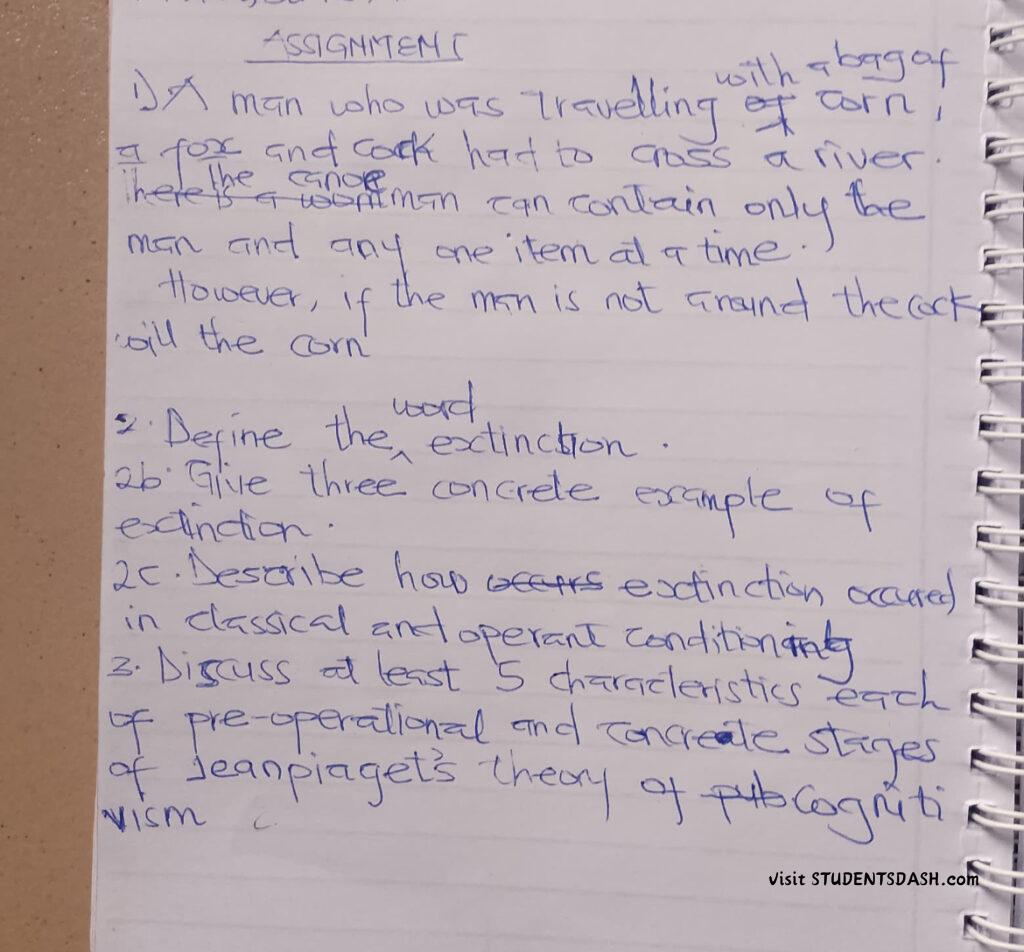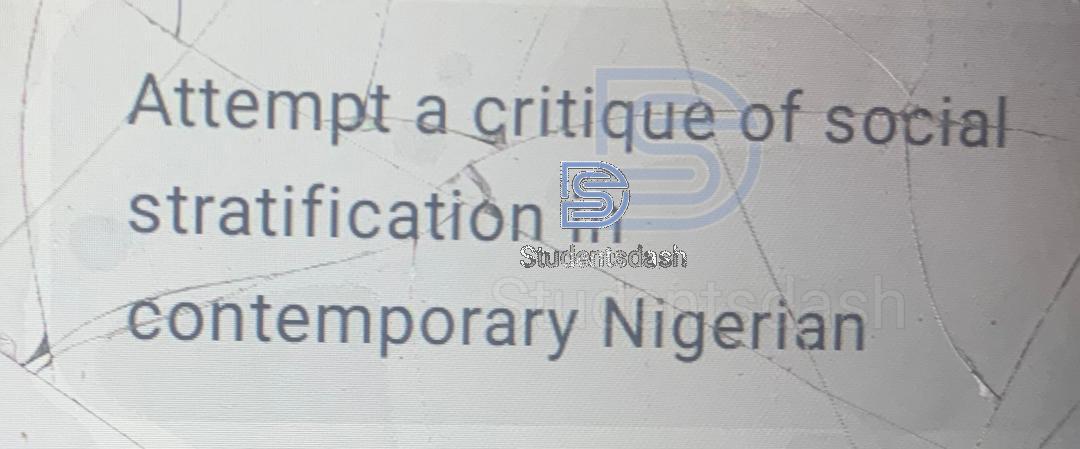EDU 101 Assignment Questions and Answers (2nd Lecturer)

Question 1
A man is travelling with:
- a bag of corn,
- a fox, and
- a cock.
He needs to cross a river using a canoe that can only carry him and one item at a time.
But there’s a problem:
If he leaves the cock alone with the corn, the cock will eat the corn.
( also we know that if he leaves the fox with the cock, the fox will eat the cock)
Goal:
Carry all three items across the river without any one being eaten or harmed.
Step-by-Step Solution:
- First trip:
The man carries the cock across the river and leaves it on the other side. - Second trip:
He goes back and carries the fox across the river.
But when he gets to the other side, he doesn’t leave the fox.
Instead, he drops the fox, picks up the cock again, and returns with the cock. - Third trip:
He drops the cock back on the first side, and this time he carries the bag of corn across the river. - Fourth (last) trip:
He drops the corn with the fox (on the other side), then goes back one last time to carry the cock again.
Final Result:
- On the first trip: Cock goes across.
- On the second trip: Fox goes across, cock returns.
- On the third trip: Corn goes across.
- On the fourth trip: Cock finally goes across.
Now all three — corn, fox, and cock — are on the other side, and nothing was eaten.
Why this works:
- The cock is never left alone with the corn.
- The fox and cock are not left together.
- The man always makes sure that no dangerous combo is left behind or on the other side without him.
Question 2
2. a. Define the word extinction
Extinction in psychology refers to the gradual decrease and eventual disappearance of a learned behaviour when it is no longer reinforced. It occurs when a previously conditioned response is no longer rewarded or followed by any consequence, leading the individual to stop performing the behaviour.
In simple terms, when a person or animal realises that a certain action no longer brings any benefit, they will slowly stop doing it. This concept is important in both classical and operant conditioning because it helps explain how behaviours can fade away when reinforcement is removed.
2. b. Give three concrete examples of extinction
1. A child crying for attention:
A young child may cry whenever they want a toy and usually gets it when they cry. However, if the parents stop giving in to the crying and no longer offer the toy, the child will eventually realise that crying is no longer effective. The crying will gradually stop. This is an example of extinction.
2. A dog begging for food:
A dog that has been fed during family meals may continue to beg. But if the family stops giving food during mealtime, the dog will notice that the behaviour no longer results in food. Over time, the dog will stop begging. This is also an example of extinction.
3. A student making noise in class:
A student who always disrupts the class to gain attention may stop the behaviour if the teacher and classmates start ignoring him. Since the expected attention is no longer received, the student will gradually stop making noise. This shows extinction in action.
2. c. Describe how extinction occurs in classical and operant conditioning
In Classical Conditioning:
Extinction occurs when the conditioned stimulus (CS) is presented repeatedly without the unconditioned stimulus (US), causing the conditioned response (CR) to gradually weaken and disappear.
Example: A dog that has learned to salivate at the sound of a bell (CS) because it expects food (US) will eventually stop salivating if the bell is rung multiple times without being followed by food. This is extinction in classical conditioning.
In Operant Conditioning:
Extinction happens when a behaviour that was previously reinforced is no longer followed by reinforcement, leading to a decrease in that behaviour over time.
Example: A student who is praised for answering questions in class may stop participating if the teacher stops giving praise. The lack of reinforcement causes the behaviour to fade.
Question 3
3. Discuss at least five (5) characteristics each of the pre-operational and concrete stages of Jean Piaget’s theory of cognitive development
Jean Piaget’s theory of cognitive development explains how children’s thinking and reasoning develop over time. Two of the key stages in his theory are the pre-operational stage and the concrete operational stage.
A. Pre-operational Stage (2–7 years)
This stage occurs between ages 2 to 7 years. During this period, children begin to use symbols, imagination, and language, but their thinking is not yet logical. The following are key characteristics:
1. Egocentrism:
Children believe that everyone sees the world the same way they do. They find it difficult to understand other people’s perspectives.
2. Symbolic Thinking:
They can use words, pictures, and objects to represent other things. For example, a child may pretend a stick is a sword.
3. Animism:
Children believe that non-living things have feelings and emotions. For example, they might say a toy is “happy” or “angry.”
4. Lack of Conservation:
They do not understand that quantity remains the same even when appearance changes. For example, they may think a tall glass has more water than a wide glass, even if both contain the same amount.
5. Centration:
They focus on only one aspect of a situation at a time, such as looking at the height of a container but ignoring its width.
B. Concrete Operational Stage (7–11 years)
This stage occurs between ages 7 and 11 years. Children begin to think logically, but their thinking is still based on concrete objects and real situations. Here are key characteristics:
1. Conservation:
Children understand that quantity stays the same despite changes in shape or appearance. For example, they know that reshaping clay doesn’t change its amount.
2. Decentration:
They can focus on more than one feature of a problem at the same time. For example, they can consider both height and width when comparing containers.
3. Reversibility:
Children can understand that actions can be reversed. For instance, they know water can be frozen into ice and melted back into water.
4. Classification:
They can group objects based on common features and understand that one item can belong to more than one category. For example, a dog is both a pet and an animal.
5. Logical Thinking about Concrete Objects:
They begin to apply logical thinking to real, physical objects and situations but are not yet able to handle abstract or hypothetical ideas.
Conclusion
Understanding the concept of extinction and Piaget’s theory of cognitive development is essential in the study of learning and behaviour. These psychological principles help educators and parents know how children learn, unlearn, and grow. By recognizing the characteristics of each stage, teachers can apply better strategies that match the child’s level of development, making learning more effective and meaningful.

